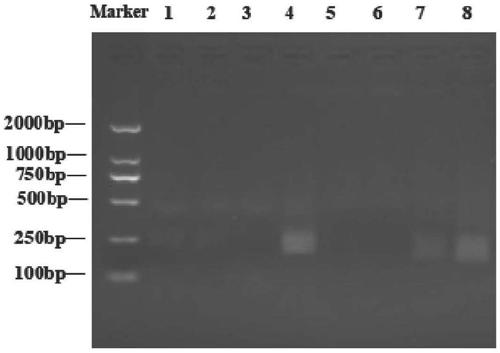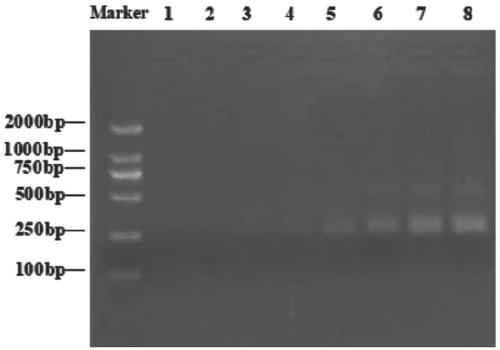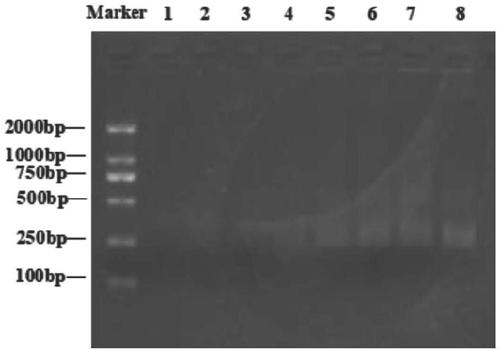Visual cascade amplification functional nucleic acid sensor for quantitatively detecting salmonellae
A technology of functional nucleic acid and Salmonella, which is applied in the field of preparation of functional nucleic acid sensors, can solve the problems of long detection time and achieve the effect of short detection time, simple operation, and qualitative judgment of detection time by naked eyes
- Summary
- Abstract
- Description
- Claims
- Application Information
AI Technical Summary
Problems solved by technology
Method used
Image
Examples
Embodiment 1
[0062] Example 1, Development and Screening of Primers for Recombinase Polymerase Constant Temperature Amplification Technology (RPA)
[0063] RPA amplification was carried out using the TwistAmp Basic kit. The system for each reaction was 50 μL, and the specific addition amount was shown in Table 1. The mixture except 280 mM magnesium acetate was added to the TwistAmp Basic reaction tube with lyophilized enzyme powder, so that The powder was completely dissolved in the tube.
[0064] Table 1, RPA gel detection reaction system
[0065] RPA reaction system
Volume (μL)
reaction buffer
29.5
RPA-upstream primer (10 μM)
2.4
RPA-downstream primer (10 μM)
2.4
DNA template
1
Magnesium acetate (280mM)
2.5
wxya 2 o
12.2
total
50
[0066] Design 9 pairs of primers to screen for better primers, and select a relatively better pair of primers for the next experiment. RPA primers are usually 30 to 35 ...
Embodiment 2
[0071] Embodiment two, the optimization of RPA reaction time and primer concentration
[0072] Set the reaction time gradient as: 10min, 20min, 30min. After the RPA reaction, perform agarose gel electrophoresis analysis. By comparing the brightness of the bands with different reaction times, select the appropriate RPA reaction time for subsequent experiments.
[0073] figure 2 , 3 , 4 respectively show the gel electrophoresis images of different concentrations of primers reacted for 10min, 20min and 30min, wherein the primer concentrations of lanes 1 to 8 are: 0.1μM, 0.25μM, 0.5μM, 1μM, 2μM, 3μM, 4μM, 5 μM.
[0074] It can be seen that under the same reaction time, as the primer concentration increases, the brightness of the product bands gradually increases, indicating that the amount of RPA products gradually increases, but there are certain differences in the products of RPA at different reaction times; in addition, it can be seen from the figure The change of the prime...
Embodiment 3
[0075] Embodiment three, the optimization of RPA reaction temperature
[0076] RPA performs nucleic acid amplification under a single temperature condition, unlike PCR, which can avoid the amplification of non-target bands caused by the combination of primers through heating cycles, especially when there is no template or low concentration of template, the reaction ends It will generate non-specific signals, reduce reaction efficiency, and affect experimental results.
[0077] In this application, there will be non-specific bands at the position of about 500bp. Try to reduce the generation of non-specific bands by changing the primer concentration and reaction temperature. It is found that different reaction temperatures have certain effects on RPA amplification. In order to reduce non-specific bands For the generation of heterosexual bands, it is necessary to select an appropriate reaction temperature for the next experiment.
[0078] Figure 5 The gel electrophoresis of RP...
PUM
 Login to View More
Login to View More Abstract
Description
Claims
Application Information
 Login to View More
Login to View More - R&D
- Intellectual Property
- Life Sciences
- Materials
- Tech Scout
- Unparalleled Data Quality
- Higher Quality Content
- 60% Fewer Hallucinations
Browse by: Latest US Patents, China's latest patents, Technical Efficacy Thesaurus, Application Domain, Technology Topic, Popular Technical Reports.
© 2025 PatSnap. All rights reserved.Legal|Privacy policy|Modern Slavery Act Transparency Statement|Sitemap|About US| Contact US: help@patsnap.com



